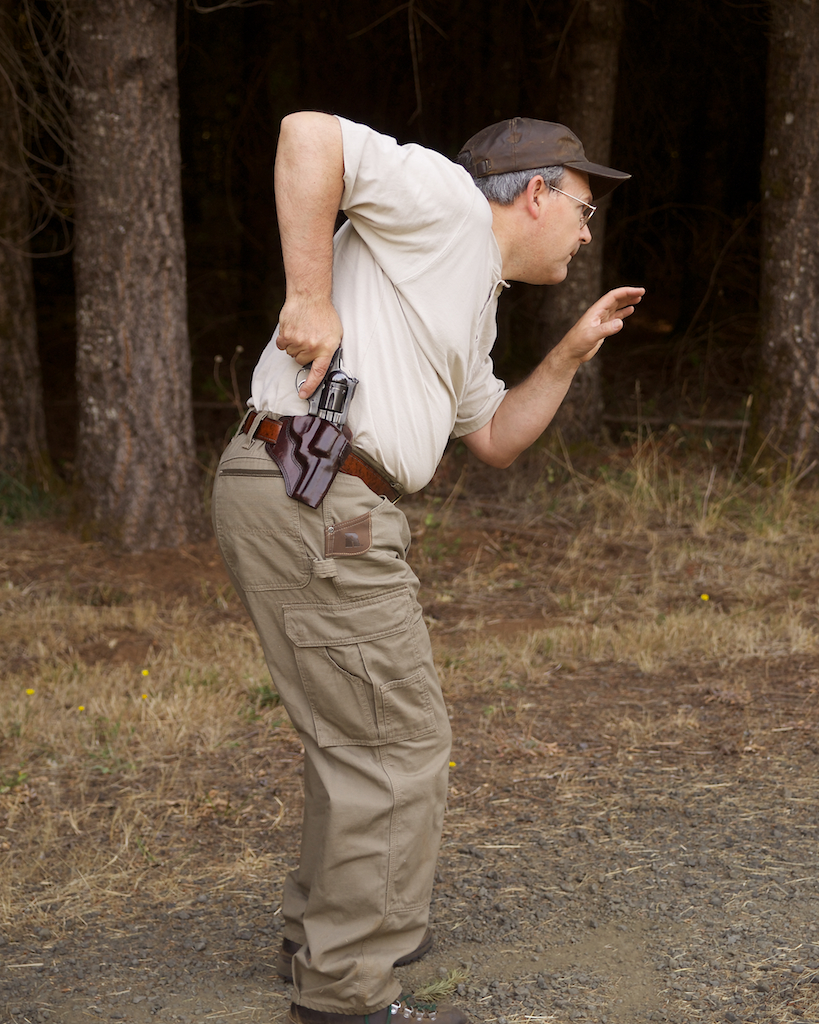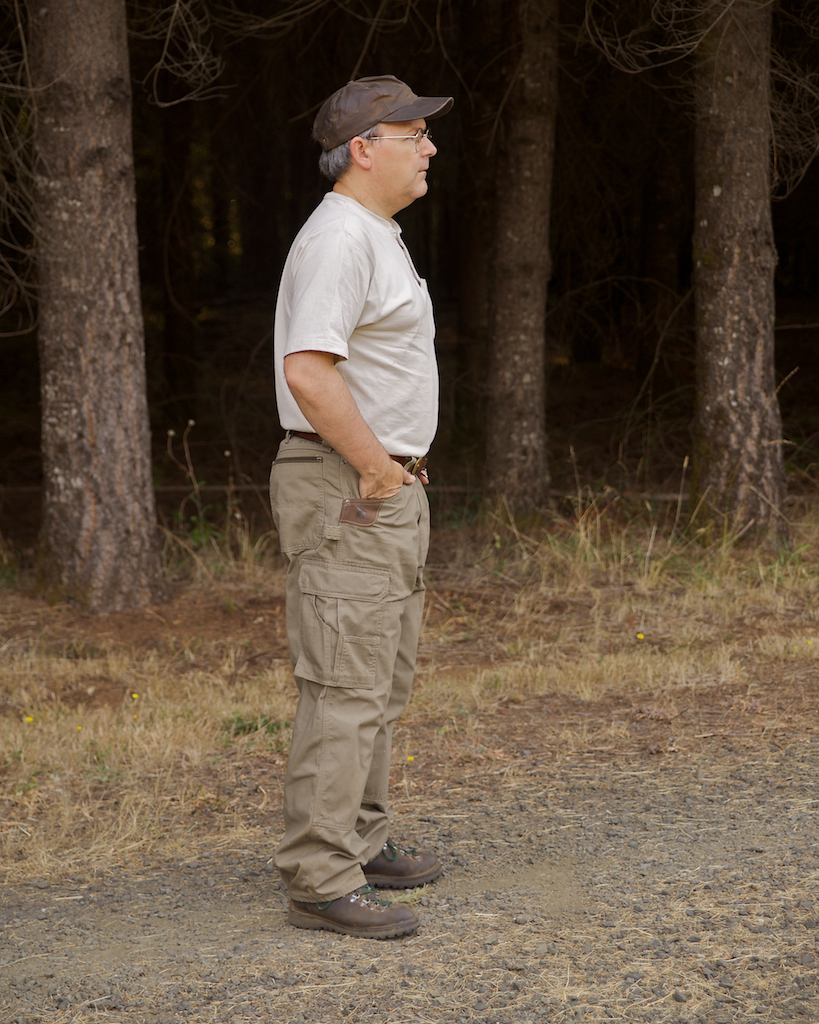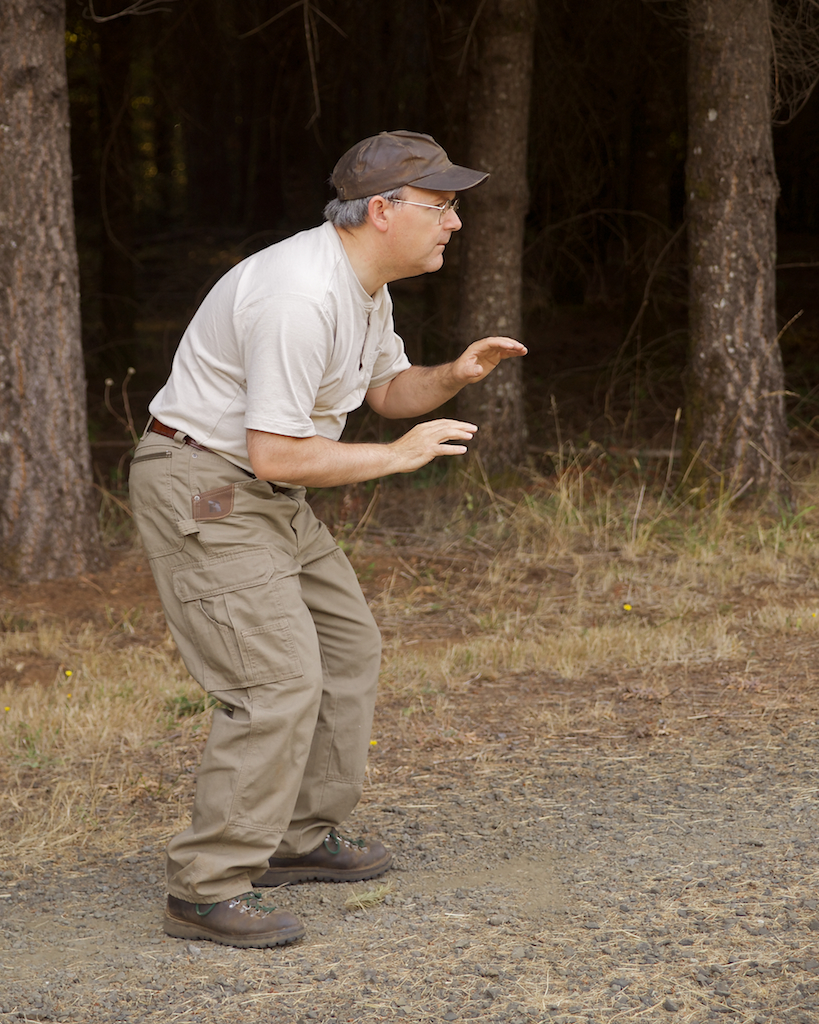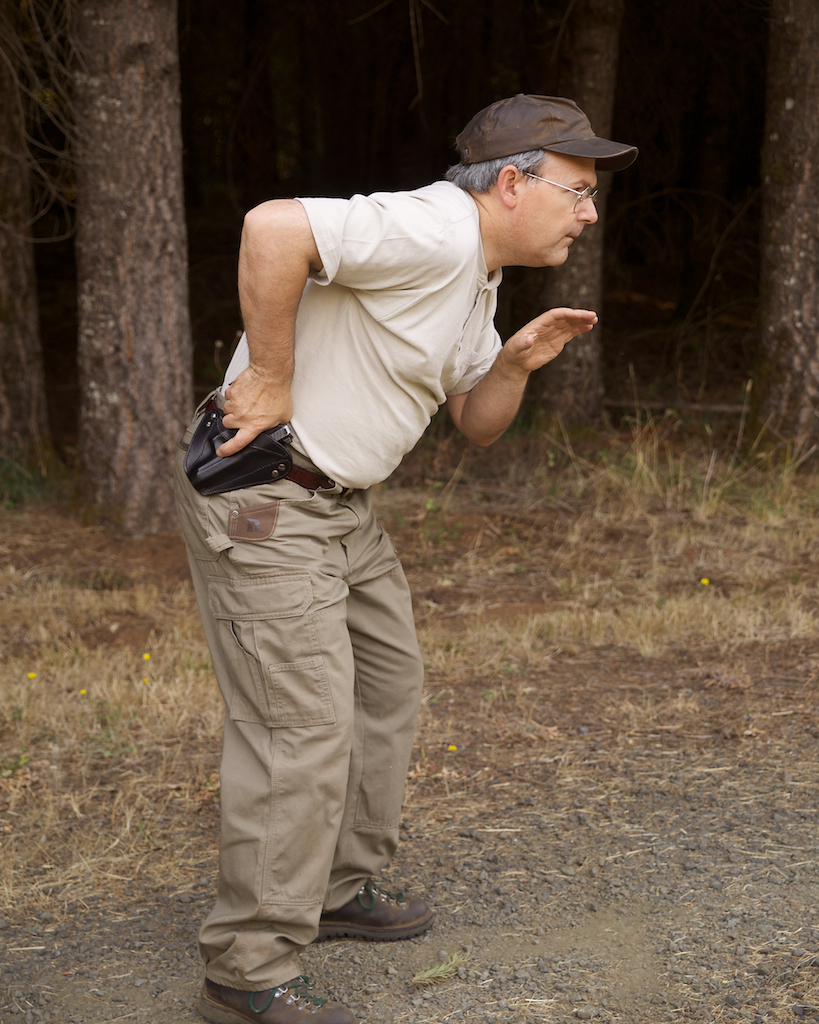About that time, “tactical” shooting matches were becoming popular, and the International Defensive Pistol Association (IDPA) was just being born. These promised to be more realistic venues for testing defensive shooting skills than traditional shooting contests, and like many other people, I decided to give them a try. I also wanted to test my equipment choices, including my holster.

Competitive shooters don’t generally like canted holsters because they’re inefficient to draw when standing upright. Note contorted arm position needed to allow a firing grip on the gun.
Beyond Concealability
Of course I wanted my holster to be concealable, but I also wanted it to be suitable for the concealed carry competitions I was shooting. At the matches, I watched closely what experienced shooters were using, as well as looking at resources such as the IDPA-approved holster list. What I ended up with seemed to be perfect.
As it turned out, it was good for only one thing: shooting matches.

In an upright competition stance, canted holster forces gun to be pulled forward rather than upward, which is neither a strong nor natural motion.
I reasoned that gun games were the ideal test of that skill, and I tried a number of holsters to hone my drawstroke after the buzzer sounded.
I started with a holster that had a pronounced forward lean, which many refer to as an “FBI cant.” I picked this holster because it is very concealable. By rotating the gun forward, the lateral dimension of the gun’s profile shrinks slightly, making it easier to conceal.
It was concealable, but in competition it had a frustrating flaw: as my hand dropped to the gun, I had to rotate my wrist forward to get a proper firing grip. That took time, and once the grip was achieved, pulling the gun out wasn’t easy. I had to pull it forward as well as up. The contortions necessary to do all that made the drawstroke both awkward and slow.
The solution, as better shooters explained, was to get a holster with no cant that carried the gun straight up and down. They explained that when I rotated my hands from the surrender position — which was the normal starting position for all the shooting contests — to the gun, I’d be able to get a perfect firing grip and lift the gun directly out of the holster. My draw speed, they promised, would increase.
They were right. At one match, I recorded several successive draw-to-first-shot times of well under a second using this new holster and a Colt Python. No wonder everyone recommended the straight-drop holster!
There was a problem, however: a concept known as “context.”
Reality Sets In
As I learned more about what really happens during violent confrontations, I realized that the matches I enjoyed shooting weren’t terribly representative of the conditions under which I expected to defend myself.
That’s because the defensive tactics fraternity has learned a lot about the realities of defensive encounters in the last ten years or so. Clinical research has taught us a huge amount about the chemical, electrical, and blood flow changes that occur when the body is faced with a lethal threat, and backing that up are the ever-increasing numbers of dash-cam and surveillance camera videos that support what scientists have been telling us.
One of the body’s natural reactions to a lethal threat is to lower its center of gravity. As that happens, the upper body bends at the waist, bringing the shoulders forward to achieve the necessary balance to keep from falling over. That forward bias puts the body in a position to respond to any perceived threat as well as to move efficiently.
Defensive handgun instructors at the forefront of realistic training have long been teaching the need to get off the line of attack as soon as possible — even before the gun is drawn. Some call it “lateral movement,” others call it “getting off the X,” but all agree that it’s in the defender’s best interest to move quickly and decisively relative to the attacker.
As it happens, that kind of movement is facilitated by the body’s natural reaction of lowering the center of gravity and bending at the waist. In fact, it’s next to impossible to move quickly and forcefully without doing those things first!
Whether from natural reactions or trained responses, when defending yourself from a lethal threat, you’re very likely to assume an aggressive, forward-leaning posture even before you start to draw your gun. If you’re serious about training realistically, you’ll adopt that posture during all your practice exercises.
When you do, you’ll find that it dramatically affects your holster choice.
Change of Venue
In shooting competitions, there’s no threat stimulus, and certainly no need (or sometimes even allowance) to move off the line of attack. Virtually all the drawing I did in even the most tactical of competitions was from a straight standing position, because there was nothing triggering my body’s desire to get low.
Remember that “FBI cant” holster I originally tried? In competition, the awkward drawstroke cost me time relative to the other shooters. It didn’t work well because the canted holster isn’t in line with the normal movement of the arm and body when in a standing position. The straight-drop holster, on the other hand, was. It allowed a solid grip without wrist contortion, and I could pull the gun straight up. This maximized the speed of the draw and is why “experts” in the game liked them. They weren’t wrong, because that holster design works well for competition. It fits the context of the activity.When I started injecting realism based on the body’s natural reactions into my training, the context changed. I now drew my gun not from the calm posture of the shooting range, but from the lowered/forward posture that is normal for someone facing a lethal threat. The holster that worked well in the competitive context wasn’t so good when training realistically.
That’s because a gun carried on a belt tends to stay in the same place relative to the hips, regardless of the position of the upper body. The shoulders, which carry the arms, move forward relative to the hips.
The normal threat reaction posture, with the center of gravity lowered and the upper body leaning forward, moves the gun backward relative to the shoulders and arms. The gun’s exit path from the holster changes in relation to the arc of movement of the hands and now has to be pulled toward the rear to release it from the holster.
That’s not the direction in which the arm has the most strength. This movement also contorts the wrist and is counter-intuitive. The mind wants to bring the gun toward the front, where the threat is, rather than toward the back.
When I started my drawstroke from where I expected to be in an actual fight — from that threat reaction posture — my straight-drop holster felt as if it locked my gun into place. It was difficult to remove, and I found myself rising to a more upright position just to get the gun out of the holster. That sort of defeated the purpose of the realistic training!
Changing Old Habits
When I realized this (and it took me about a year — I’m a stubborn learner), I changed to a forward-canted holster. That design was not suitable for competition but perfect for realistic defensive shooting practice because it conformed to what my body was most likely to do in a real life-or-death struggle.

Straight-drop holster requires gun to be pulled backward relative to shoulder position and is as mismatched as the canted holster is from a competitive standing position. Elbow has reached its upper limit, and the barrel hasn’t yet cleared leather.
Our body’s natural reactions affect not just how and what we train, but what we train with. Any piece of hardware you carry, whether it’s a gun or a holster, needs to work well with what your body is going to do naturally.
That’s not to say that anything else is absolutely unworkable, because that would fly in the face of recorded history. People have successfully defended themselves with all kinds of guns and holsters. Can you use a straight-drop holster for defensive encounters? Certainly, but you need to understand that your hardware choice affects your efficiency. The more efficient your response, the less time you’ll be exposed to danger and the less chance you’ll have of being injured or killed during the confrontation.
Again, it’s all about context. What works well in the controlled environment of a shooting match is not necessarily what will work well in a fight, and vice-versa. The variable? Our body’s natural reactions when under threat.
Pick your gear for the fight you’re likely to have, not the one you want to have. Test that gear under realistic conditions, the kind under which you’ll actually fight, rather than the make-believe conditions of the competition shooting range.
Share tips, start a discussion or ask one of our experts or other students a question.
Already a member? Sign in






I use a VersaCarry Protector leather holster. I works extremely well in the roughly 4 o'clock position, the slight forward cant helps get the hand to the weapon very well. I used a blue gun version of my EDC to use and eliminate several holsters before going to this one. BTW, it is the very same holster I used for my previous EDC - a 1911. So there is that. Tossing a lot of marketing holsters away a few years ago freed up nearly an entire drawer too!
Good points. Thanks. For what it's worth your pictures show a real need to point out that your support hand is "looking" for a hole in it from your shoot'n iron. Not to mention that while your support hand is flaying around while catching up with your gun your loosing time. May I suggest that you learn (train) to put your support hand flat against your chest while drawing a at stage 3 (step 3) of the draw move your support hand up and meet your gun to establish a good grip. Getting your support hand out of what could be the line of fire just might save you a hole in your hand (not to mention probably loosing the fight while you deal with the pain).
I am a NRA certified pistol instructor but I spend most of my instruction time handling the concealment portions of the courses I teach in because I also own Archangel Gun Leather and make holsters. Carrying on the hip not only is difficult when sitting is it harder to conceal and defend your firearm. Behind the hip allows you to put your body between an attacker and your firearm making it more difficult for the attacker to disable your drawing the firearm. Ever think about that? What happens if they jump your butt before you can draw your firearm? The 90 degree cant at the 3:00 is perfect as you move to 3:30 15 degrees is better and at 4:00 up to 30 degrees becomes more ergonomically correct as you are matching the angle of your arm for a straight pull from the holster. From a concealment perspective behind the hip only makes sense. On the hip (cowboy carry) may be the fastest drawing position for competition but for daily carry and CCW it is less than perfect. You will find yourself catching the rig on tables and benches in crowded conditions. I is horrible from a sitting position and quite frankly hard to conceal the lump on your hip.
A good article but it actually considers two situations - standing and crouching. If you've ever had to setting in your car - the drastic cant makes it so you almost can't.. If you've had to go to the ground and try to draw with that cant - ... Also, body type enters in for some folks as well, especially the ladies. But some men as well. A compromise with not being vertical and not as slanted as you show is much more versatile. That drastic cant was designed for a 5 or 6 O'clock carry and it works well for that. But I don't like setting on my gun. Many holsters to allow some adjustment which allows more freedom and more options. I don't think a "one solution" as listed here will work for everyone nor for may practical situations. And remember, the FBI has much less experience with this sort of thing than your average city police force. They can be a good source of info, but their experience doesn't match that of a major police force.
Wonderful article. Certainly gives me more to think about for my next holster purchase. Thanks for being realistic. Some folks who publish articles, don't live in that world. Thanks again.
have a very good read. I appreciate you for sharing!}
I am firmly convinced that 98 percent of the holsters I have - and it is a lot- were designed or made by folks who never wore a gun in their entire lives.... Uncomfortable, unconcealable, just pitiful....I think I see why Wild Bill Hickock carried his guns in a wide sash on his waist....
I am from the old school also. I like a straight cant holster, but mid ride, however, no luck in finding one for my duty weapon G23, or my back up s@w model 60 and walters pk380. Any suggestions?
Spot on...same concept that makes most martial arts training unrealistic. Human reaction to stress and threat is very predictable yet rarely considered when developing "techniques" for self defense. Interesting to note that when I went thru the FBI academy in 2005, they had switched to a straight up holster cant (12 o'clock) because they felt this led to the fastest draw (after consulting with the best competition shooters in the world). I never bought in and always carried at a slant.
"Wordsmith" - go back and re-read the article. The crouch isn't something you CHOOSE to do, or something that's added to the drawstroke. The crouch - specifically, lowering the body's center of gravity and orienting toward a threat - is what the human animal does naturally and instinctively when surprised by an attacker. In the timeline of the attack, it's already happened. An unrealistic training model where one stands erect while drawing the gun doesn't reflect the reality of what our bodies are going to do, because it places the hand and gun in positions they are unlikely to be when the attack occurs. Can you train to stand up from the crouch to draw the gun? Certainly, but it's more efficient to draw from the position we're already in - which usually ends up being some degree of a crouch (the pictures are slightly exaggerated to clearly show the positioning.) There is a ton of both clinical research and objective (video) evidence of actual encounters which predicts and verifies this instinctive behavior. Google "body's natural reactions" and start reading.